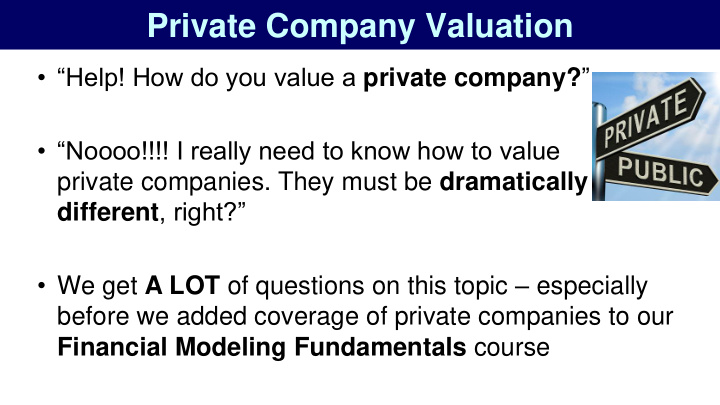



Private Company Valuation • “Help! How do you value a private company? ” • “Noooo!!!! I really need to know how to value private companies. They must be dramatically different , right?” • We get A LOT of questions on this topic – especially before we added coverage of private companies to our Financial Modeling Fundamentals course
Private Company Valuation • To answer this question, I’m going to summarize our 10-hour-long private company tutorials in 20 minutes (wish me luck!) • Case Study #1: Large private company • Case Study #2: Actual small business • Starting Point: Think about Breaking Bad !
Private Company Valuation • Walt is explaining his obsession with crystal meth, but he also lays out the 3 types of private companies
3 Main Categories: • Money Business: Small, family-owned business or something heavily dependent on one person • Meth Business: Venture-backed startup planning for exit • Empire Business: Large company with Board and management team; it isn’t public but it could be
What About Private Companies? • “Empire Businesses” (Large Private Companies): Almost the same as public co’s; minor differences • “Meth Businesses” (Startups): Still very similar, but a few more differences (e.g., IPO valuation) • “Money Businesses” (Small Businesses): Most differences emerge here – but you rarely work with these in IB/PE unless you’re at a small firm
What Exactly is Different? • Accounting & 3-Statement Projections: Mostly an issue for Money Businesses – adjustments required! • Valuation: Private companies might be worth very different amounts to different buyers / investors; illiquidity and other discounts often applied • DCF: No “current” capital structure and no Market Cap, so Cost of Equity and WACC are tricky
Accounting / Projections: • Non-GAAP / IFRS Statements: May have to normalize the categories • Salaries / Dividends: May need reclassification • Business / Personal: Intermingled! • Tax Rates: Personal / small-business rate may differ from corporate / acquirer’s rate
“Money Business” Income Statement:
Normalized Version: • Changes: More normal categories, added in the owner’s salary, removed personal expenses, and the tax rate will change in future periods
Valuation: • What’s the Purpose? Sale to private co. or individual different from sale to public co., IPO, fundraising, or spin-off • Illiquidity Discount: Almost always applied to public comps used to value private companies • Discount Range: Might be 10-30%? Depends on the size/scale of the company and the valuation’s purpose
Public Comps: • BUT… we’d need to discount these multiples for a true “small business” – a $5 million revenue company can’t be compared to a $500 million revenue company
Public Comps: • But you might not apply this same discount for the Precedent Transactions since they already reflect the control premiums paid by buyers (and the discount would be much lower for Empire Businesses)
Precedent Transactions: • No huge differences, but you might use more “creative” metrics, especially for tech start-ups:
DCF Problems and Differences • Problem #1: The Discount Rate • Should be higher for a private company – more risk! • But how do you calculate it when the company doesn’t have a market cap or Beta? • Problem #2: Terminal Value • Similar for Empire Businesses and Meth Businesses, but must be discounted for Money Businesses – what if the owner dies?
The Discount Rate • Cost of Equity and WACC: • Use industry average or comps’ average capital structure? • Use firm’s “Optimal” capital structure? • Circular logic, where DCF output is fed into company’s “Market Cap”? (Not recommended) • Track volatility of earnings for Beta? (Questionable)
The Discount Rate • Many approaches, but you’ll likely end up just using the median capital structure of the comps for this
Terminal Value • Terminal Value: May not make sense for a true small business – can it really operate “forever”? • Option #1: Heavily discount the Terminal Value • Option #2: Skip and project FCF far into the future • Option #3: Terminal Value = Liquidation Value
Terminal Value • End Result: The company will not be worth as much as a public company, particularly far into the future
Final Thoughts • Private Companies: What type of company is it, and what is the purpose of your analysis? • Empire Business: Few differences; minor discounts • Meth Business: Greater discounts/adjustments • Money Business: Significant discounts to comps’ multiples, Terminal Value in a DCF, etc.
Final Thoughts • No new methodologies , multiples, etc. – just variations and tweaks of old ones • Basic Point: Private companies < Public companies • Accounting: Tweak and reclassify the statements • Valuation / DCF: Illiquidity discounts, rough estimates for Discount Rate, and discounted Terminal Value
Recommend
More recommend